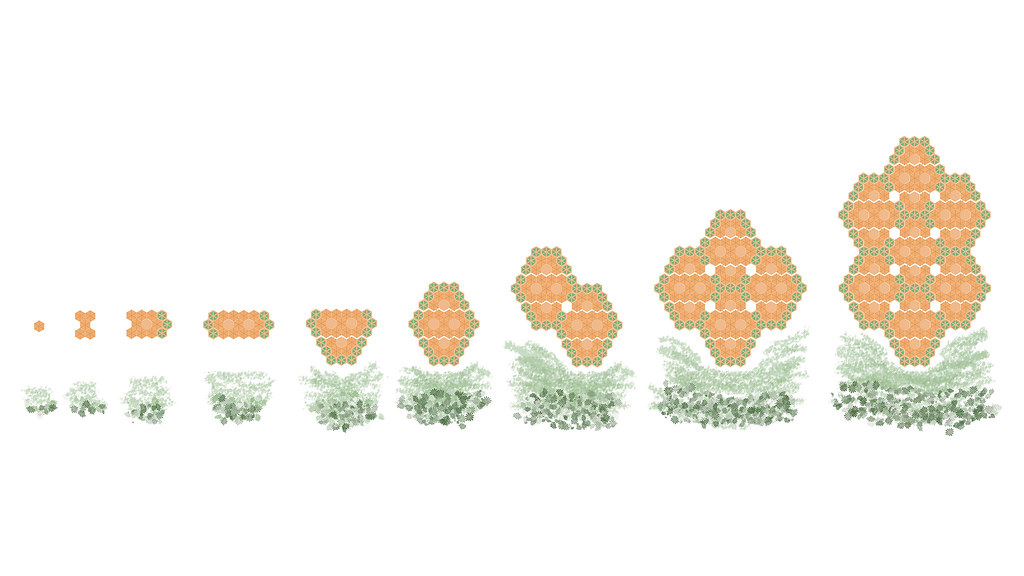Samuel Wright, Tobias Ng and Maria Valderrabano wanted to strike the perfect balance between sustainability, vernacular design and innovation for their entry into the IStructE Young Structural Engineering International Design Competition. Using the strength and tessellation of repeating hexagons, their vision for a hive of floating homes offers resilience for communities facing rising sea levels due to climate change.
Working with nature
Bamboo is strong, versatile, fast growing, and indigenous to Southeast Asia. This makes it a great choice as a building material for remote, flood-hit communities in areas like Bangladesh. But it also only has a structural lifespan of two or three years.
For Sam, Tobias and Maria this is all part of the natural cycle: 'We wanted to only use natural renewable materials in our design. This inspired our philosophy that, as the natural materials that constitute our buildings regrow, so must the structures replenish themselves.
'Our design approach was majorly influenced by Bath’s focus on sustainability and the process of how to generate ideas and design solutions. At university, we are encouraged to create a thoughtful and powerful concept, and then let the technical details emerge in unison.'
The hive of repeating hexagonal structures with traditional hipped thatched roofs, open walkways and connecting bridges is designed to respond to changing materials, tides and community numbers. This is all achieved by the clever use of connectors and joints.
A flexible design
The floating platform rests on bamboo poles driven into the ground and surrounded by sand and brick. Six bamboo poles acting as columns and six as floor beams create a modular hexagon. Each beam is connected to four other structural members forming a six-way joint secured together by stainless steel dowels and nylon ties.
As well as providing structural strength, each hollow pillar can act as stack ventilation shafts or used for water storage. Loosening the ties and dowels allows single bamboo columns to be lifted out and replaced when needed, with the remaining five bamboo pillars acting as support during the process.
Moored between the residential buildings are floating rafts made from salvaged plastic barrels. These rafts provide floating gardens, courtyards, recreational areas and markets. Rope connections between the rafts and bamboo structures allow for changes in tides and water levels.
With rising sea levels threatening communities in South East Asia, the team anticipated a cultural shift toward fishing and boat-based living. The large circumference of the hive settlement provides plenty of mooring space, and farming rafts can be swapped with port rafts to allow greater shipping infrastructure.
'Encouraging the use of boating infrastructure turns the unstoppable threat of rising sea levels into a positive, rather than tackling the well-established negatives of tirelessly fighting against nature.'
Building the hive

Part of the brilliance of the design is its simplicity. The repeating shapes are intuitive, minimising the need for complex instructions and expensive equipment. More hexagons are added as the settlement grows, and as community needs change rafts can be disconnected and floated to different locations.
'It was essential to us that our design empowered local communities to adapt and adorn their settlement around their lifestyles. We believe this is the only way it can become truly successful and sustainable.'
The diameter of the bamboo used in construction decides the total size the hive can reach. Once one side length is known, the entire structure is then set out by proportion. The team refers to this as "inbuilt geometric security" and this prevents the hive from becoming too large and collapsing.
The simple and sustainable construction method, use of local materials and fine detailing on how the design relates to the climate, culture and situation of Bangladesh, won the team the Undergraduate Prize in the Young Structural Engineering International Design Competition.
'At first we were shocked to have won as we felt our design was so ambitious. The judges praised our cultural research and consideration for the community, which showed us the power of focusing on the social impact of every part of the concept at every stage. Something we hope the take forward is to focus on the "civil" side of the profession as much as the "engineering". This prize has definitely given us more confidence in pursuing that.'
